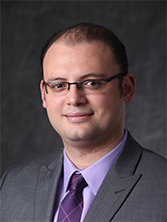Seminars
Dr. Mohammed Alnaggar
Nuclear Energy and Fuel Cycle Division
Oak Ridge National Laboratory
Multi-scale Multi-physics Simulation of Cementitious Materials Aging and Deterioration

ABSTRACT: Concrete is the second most used material in the world after water. It has proven its efficiency over millennia. This widespread of its use in different environments and applications as well as the rapid changes of its constituents are making it more and more challenging to understand and predict its behavior. Fundamentally, concrete is formed by binding inert materials (aggregate and fillers) using a porous cementitious binder that is chemically active from the onset of adding water up to the end of the material life. It is this binder that controls most of the concrete unique characteristics over its full service life. Therefore, a better understanding of how this binder evolves and its interactions with the inert materials, reinforcement, loading, and the environment is crucial to the control over the finished product response (structural response). In this presentation, emphasis on the multi-scale nature of concrete behavior that explains the different phenomena captured at different length scales will be presented (the length scale axis). It will be argued also that it is only possible to understand, predict, and thus control the time-dependent behavior by representing such phenomena at the correct length scales (the time scale axis). Given the fact that most of the aging and deterioration phenomena are functions of heat and mass reactive transport, the modeling of these multi-physics will be also presented along with the different presented scales.
BIOGRAPHY: Mohammed Alnaggar is a senior research scientist in the Nuclear Structures and Construction Group in the Nuclear Energy and Fuel Cycle Division. He received his Ph.D. from Northwestern University in 2014 in structural engineering. Before joining ORNL, he was an assistant professor at Rensselaer Polytechnic Institute. His research focuses on formulating advanced computational models for describing cementitious materials time-dependent behavior under various loading and environmental exposure conditions. Recently he developed novel concrete 3D printing techniques to enable printing concrete with reinforcement and supports.